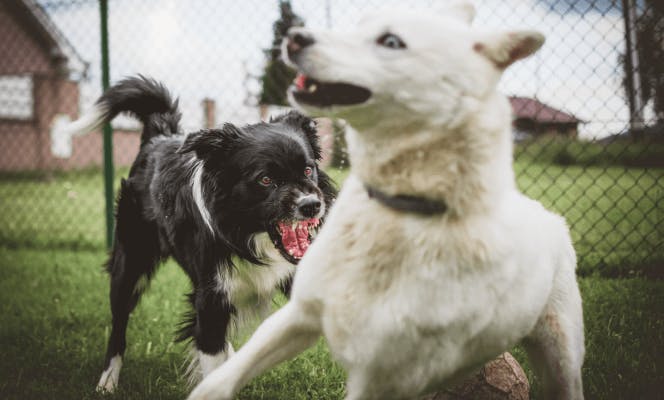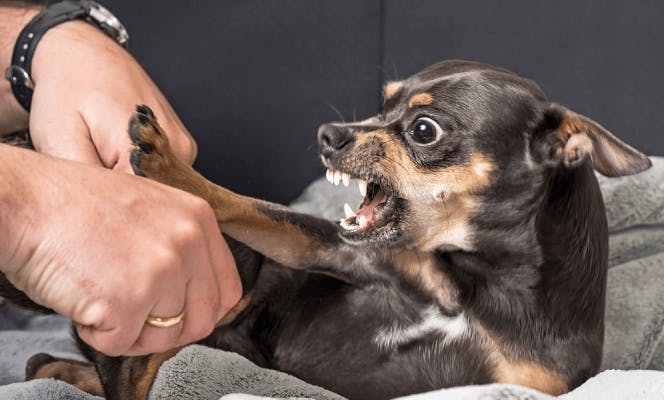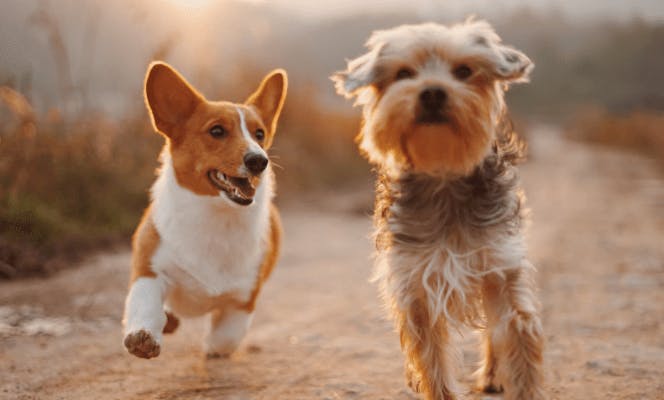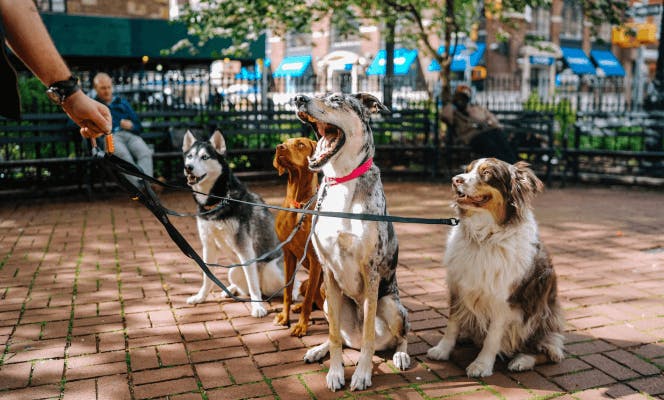How To Stop Puppy Aggression
By Mawoo Pets · 9 min read
Last updated: July 12th, 2023

Does your puppy nip or growl at you, other pets, or people? Some behaviors are normal in all puppies, but dogs aren’t likely to just outgrow their youthful aggression or bad manners. If left too long without proper training, your sweet but poorly behaved puppy could turn into a bad-mannered and scary dog. Learn how to stop puppy aggression now, so it doesn't become a learned behavior into adulthood.
The first step is to identify aggressive behavior and look for any triggers that seem to bring it out in your dog. Then, you can find a way to work together with your dog to find a way to soothe that aggression and misplaced excitement.
Normal Puppy Play vs. Aggression: How to Tell the Difference
The usual signs of an aggressive puppy can be easy to miss just because they blend in with normal puppy behavior. As your puppy grows day by day, he gains confidence, energy, and an increasing ability to walk, run, jump and play. It’s totally natural for puppies to play a bit roughly with each other as they learn to use their jaws, paws and legs. All happy litters of little dogs bite and kick each other. That’s how they learn and grow.
So how can you tell if your puppy is just innocently playing with you or your child, or if there’s a problem? There are a few key behaviors to look for. If your dog displays any of the following signs of puppy aggression you need to pay attention:
Snarling
Growling
Snapping
Staring
Barking aggressively at you or a playmate
Biting
Curling its lips
Lunging at you or others
Mounting its playmates
Common Causes of Puppy Aggression
Those common signs of an aggressive puppy might happen once and never again, but it’s when you see this behavior repeated multiple times that there is a problem developing. Some breeds may have more natural tendencies towards aggression than others, but every breed of dog can be trained out of bad habits! Don’t let prejudice against so-called “bully” breeds fool you into avoiding dogs like bulldogs or pit bulls. All dogs with bad behavior—big or small—were either improperly trained as puppies, or worse, purposefully trained to become aggressive.
Usually, there is one of three simple reasons behind a puppy’s aggression: Fear, pain, or territorialism. The key to solving aggression in puppies is figuring out which problem is causing him to lash out. When you know what’s wrong, you can start to fix the problem and make you and your puppy more comfortable.
Fear and Lack of Socialization
 Photo by Tadeusz Lakota on Unsplash
Photo by Tadeusz Lakota on Unsplash
Fear is a strong emotion, especially for a young, tiny dog. It’s not hard to understand how a little puppy—especially one just weaned from its mother and moved into a new home with you—can find literally anything scary. Everything in a human home is big and scary often loud, including you! Puppies’ fear can turn into aggression or even anxiety if left to fester, so it’s very important for the health of your puppy that you help him overcome this emotion.
The best way to combat fear is with exercise. Lots of exercise.
Think about it this way: Fear and anxiety are the product of excessive energy in the body. So, if you can help your pup work off that energy, the negative emotions will weaken. Even better, take your puppy for long walks and playtime sessions with other dogs, to work on social anxiety. The earlier your puppy meets other dogs, animals and people, the better.
Pain or Rough Play
Sometimes, if you see signs of aggressive puppy behavior, it’s more to do with other dogs than your own. For example, if your puppy is at the mercy of a bigger or more aggressive dog who plays rough and causes him pain, you might see him act out to defend himself. After all, what else can a little dog do? If this is a problem for your puppy, it’s up to you to step up as the pack leader and ensue normal play.
“Pack leader” is an idea that comes from dogs’ and wolves’ natural behavior in the wild, where they form social packs and select a strong leader to protect them. In your home, even when you don’t mean to, you usually act like the leader of your pack of dogs (or dog.)
As leader, it’s your responsibility to separate your pup from other badly-behaved dogs and make sure it feels safe and secure. Taking that role will help your puppy feel confident, and help stop him from developing a counter-aggressive personality.
Possessiveness or Territorialism

Territorialism is a common issue with many dogs, who instinctively feel the need to protect their home and personal space from other people and animals. Possessiveness happens when that same instinct is transferred onto your dog’s “property” such as toys or bedding. Though territorial aggression is mostly pointed at strangers, it can sometimes affect other family members, whether human or animal.
At home, you’ll usually see a dog’s territorial and possessive behavior centered at the windows and doors. It can often be triggered by the sound of the doorbell or someone knocking. Aggressive dogs might bark ferociously at the door, then lunge and bite once someone enters the house. The same thing can happen outside of the house when a dog thinks it has ownership of you and your family, or of a particular space.
The best way to avoid this type of aggressive behavior in puppies is to immediately start training them about visitors and other creatures. Socialization is key, again, so you can demonstrate to your puppy that you are friendly or confident in the presence of other people and animals.
Train your pup to sit when someone approaches it, or knocks on the door, and reward him or her with a treat every time. Whatever you do, don’t punish your dog! Training works much better with positive reinforcement. Teach your dog that rewards come with good behavior.
Common Warning Signs of Aggression in Puppies
Most dogs use the same coping mechanisms to deal with fear, pain or territorial feelings, which makes it easy to see when something’s not quite right with them. As long as you know the signs of puppy aggression, you’ll be able to identify them right away and do something about the problem. Seeing the issue is the first and most important step to fixing aggression in puppies.
Growling, Snarling, or Baring the Teeth
You already know that growling is a sign of aggression in all dogs. It happens when a dog feels threatened and tries to scare away the source of the danger. Many animals use this same tactic to communicate with members of their own species, as well as other types of animals. Snarling works the same way, while baring the teeth is meant to warn everyone that biting could follow.
If you have young children, they may not understand the dangers of this behavior. As a parent and dog owner, stay especially alert of such behavior when your dog is playing with children. If you notice signs of aggression, use one of the techniques outlined below to prevent a dangerous encounter (e.g. bite inhibition).
Though you might think simply backing off would make an aggressive, snarling dog feel better, the truth is more complicated. In fact, giving in to a dog that is being aggressive simply reinforces that behavior, showing the dog that it has done the right thing in getting the threat (you) away.
Snapping or Biting
Aggressive dogs don’t necessarily bite, but they definitely want everyone to think they might! If biting is the final step in attacking an animal or person, then snapping or nipping is the last warning before that happens. Usually, an aggressive puppy will growl then nip before finally biting the person or thing that has upset them. This is probably the most dangerous bad habit a puppy can form, since the bigger a dog grows, the more damage a bite can do.
If you don’t manage this behavior when your dog is still a puppy, it can develop into a permanent coping mechanism that is almost impossible to fix. When you see dogs out in the park with muzzles over their snouts, that’s exactly what has gone wrong. Don’t let that happen to your sweet puppy!
If he bites during play, let him know you don’t like it with a high-pitched yelp. Make the same sound he would make if he were in pain. This will surprise him and get him to stop, for now. Keep up that behavior and stop playing when he bites. This teaches him that biting hurts you and ends the game.
Lunging at People or Other Pets
 Photo by Viktor Nikolaienko on Unsplash
Photo by Viktor Nikolaienko on Unsplash
Lunging is another common aggression tactic used by dogs. Somewhat confusingly for you as an owner, lunging also happens when totally friendly and overexcited dogs are desperate to greet someone. To know the difference between these motivations, you have to get to know your puppy’s personality. Is it a happy and naturally friendly dog? Does it love meeting new people? If so, the lunging is probably from excitement. If not, you might have an aggressive puppy on your hands.
Like biting and nipping, lunging is best tackled from puppyhood, using a leash. Leash training can help with this problem no matter what the cause. When you know your dog is about to lunge, distract him gently with a tug on the leash or by touching him on the chest.
Overly Possessive of Food or Possessions
One more sign of aggressive puppy behavior is possessiveness over toys and food. Feeling possessive over these things makes a dog lunge, nip, bite, and all the other common bad behavior we’ve already talked about. For some dogs, the problem is anxiety over when the next meal or treat or toy might be coming. For others, food aggression is because they want to make sure they eat first, since they consider themselves the alpha dog.
Working with your puppy to overcome food possessiveness starts with a feeding schedule. When your dog knows meals are coming regularly throughout the day, he won’t be so anxious about hoarding the food he already has. Before your puppy eats, teach him to sit calmly and still. Then, reward him with his meal!
How to Stop Puppy Aggression
To help your puppy understand what sort of behavior you like best from him, focus on rewarding his good habits. When he’s being sweet and calm, praise him and give him treats. When he’s learning to sit, lie down, and stay, be sure to do the same as he starts to learn what you’re asking. Reinforcing good behavior is one of the most important methods of stopping bad behavior.
Crate training is also a popular method of dealing with an aggressive puppy or older dog, and it can be used alongside positive reinforcement. When your puppy starts to bite, bark too much, or show other signs of aggression, put him into his crate with the door shut. It’s not punishment, but it isolates him so he is no longer stimulated to bark, bite, etc. The crate needs to be big enough for your dog to stand and turn around comfortably. Put some toys in there to help focus his energy on them instead of people and other animals.
Identify and Avoid Triggers
Figure out what’s causing your dog to lash out in the first place, so you can avoid unnecessary triggers. For example, is he terrified of other dogs? Does he bark incessantly when the doorbell rings? Consider getting rid of the doorbell for now, and keep him away from other dogs until you’ve helped him make friends with one first.
This isn’t about avoiding life and keeping your dog away from the world, mind you! It’s about figuring out what causes your puppy anxiety or fear or territorial aggression, and minimizing those triggers until you’ve trained him to accept them.
As an owner, this means you have to keep a close eye on your puppy and learn everything you can about his specific form of aggression. Does it come on in social situations? Is food always involved? Keep watching and you’ll be able to figure out the pattern.
Use Positive Reinforcement
 Photo by Alvan Nee on Unsplash
Photo by Alvan Nee on Unsplash
To use the positive reinforcement method of puppy training properly, you have to deliver a treat immediately after your dog does what you want. For example, if you’re training her to “sit” and she doesn’t get the treat until after she’s already stood back up, she won’t associate the treat with the right behavior. Keep things simple at first, starting with “sit,” “lie down,” and “stay.”
Once these tricks are learned, it’s easier to target those signs of puppy aggression you’re worried about. Is your puppy lunging towards people out of fear? Teach her to sit before being introduced, then praise her and give her a treat right away. Sitting before a door gets opened, or before your dog can greet another dog, is another great way to prevent bad behavior. Food, praise, and toys are the most effective treats for dogs learning new things.
Provide Socialization
When you buy your puppy from a caring breeder, the socialization process should already have begun before you even bring your new dog home. This is very important, because the first few months of your puppy’s life are crucial for socialization training. You need to continue the process of introducing your puppy to new dogs, other animals, and people who don’t live in your household.
It's also a good idea to show your pup different objects and environments, so that everything outside of his home doesn’t cause him anxiety later on. Help your dog create good associations with everything new—from shag carpeting to the giant (friendly) Doberman down the street. Pet him, use a happy and gentle voice, and give him treats along the way. This is another time when basic tricks like “sit” are extremely useful. Have your puppy sit before meeting new animals, to reinforce a feeling of calm.
Interrupt and Redirect Method
The Interrupt and Redirect method of behavior training is one you have likely seen before, by dog trainers such as Caesar Milan. The point is to notice when your dog is about to bark, lunge, bite, etc. and distract him before the bad behavior happens. Once you’ve distracted him, you can bring his attention and energy somewhere better. Over time, the urge to bark or bite in similar situations will fade.
Here's an example. You’re walking your puppy and he sees another dog wandering around off-leash. You’ve seen this before and know he’s about to start barking like a crazy dog while pulling at the leash. Move quickly! Before that happens, do something to distract him. Whistle, or make a clicking sound, or come up with some other unique sound that your puppy won’t hear any other time. When he gives you his attention, reinforce that response with praise and treats. Then, redirect the original behavior into something simple, like sitting, or walking past the object of excitement.
Give a Time Out
 Photo by Matt Nelson on Unsplash
Photo by Matt Nelson on Unsplash
When you’re at home and see your puppy misbehaving aggressively, go ahead and give her a “time-out” just like a kindergarten teacher would do. This is where crate training comes in again, since the crate (AKA kennel) is the perfect place for a time-out. It’s also the ideal spot for your dog to hang out when she wants some time to herself.
Don’t use a crate just for training purposes. Put it somewhere in your home where your puppy can always find it. Fit it with a comfortable bed and some toys, and leave the door open throughout the day for your puppy to use when she wants. Then, those times when you see her being aggressive, put the puppy in his crate with the door shut. This also works to interrupt the bad behavior and put the dog into a place that feels calm and safe.
Work with a Trainer or Behaviorist
Working with your own puppy to develop good behavior and social skills is priceless, but professional help from an experienced dog trainer are pretty valuable, too. You know those times when your puppy does something it shouldn’t, but you find it so cute that you don’t care? Well, a trainer won’t let your dog keep jumping up on people, or licking strangers’ faces, or whatever it is you think is too adorable to scold him for. That’s going to make your friends more likely to visit!
Also, if you are a less-than-confident trainer, your attempts to show your dog how to behave might just be confusing it more. It’s not an ideal situation, but it happens—and that’s why a professional dog trainer or dog behaviorist is always a good idea. Think about consulting a professional if your lessons don’t seem to be sinking in. The sooner, the better.
Do Puppies Outgrow Aggressive Behavior?
The short answer is, no, puppies won’t simply outgrow their aggressive behavior. That said, most puppies do have a biting phase that won’t necessarily stick around—it’s the same with many animals, who learn to use their jaws and teeth on their siblings when young.
Normal, playful puppy bites during this phase should still be monitored closely. If it hasn’t disappeared after the age of about five months, you need to intervene and actively train that behavior away. Other signs of aggression in puppies, like excessive barking, lunging, snapping, and showing teeth, will only become more habitual as your pup grows into an adult dog.
The older your puppy becomes, the harder it will be to correct these types of behavior. Make sure you address it right away, either on your own or with the help of a professional trainer, to avoid trouble in the future. Adult dogs can still learn to correct problem behaviors, but many aggressive behaviors can be best corrected at a young age.
Often, the best way to make sure your puppy behaves appropriately is to make sure you find the right dog for your lifestyle and environment. If you bring a puppy into your life that is naturally suited to your schedule and home, training will be much simpler and both you and your pup will be happier.
Take our Dog Breed Quiz to find out which dog breeds will be the happiest in your home! A good match means less work for both you and your puppy, and much less chance that your new little friend will develop aggressive habits.
Related articles
Related puppies for sale
Any questions? Get in touch!
We are here to support you every step of the way. Our concierge service is here daily to answer your questions!
Chat or speak with our team Mon-Sat 9a-9p ET.



























